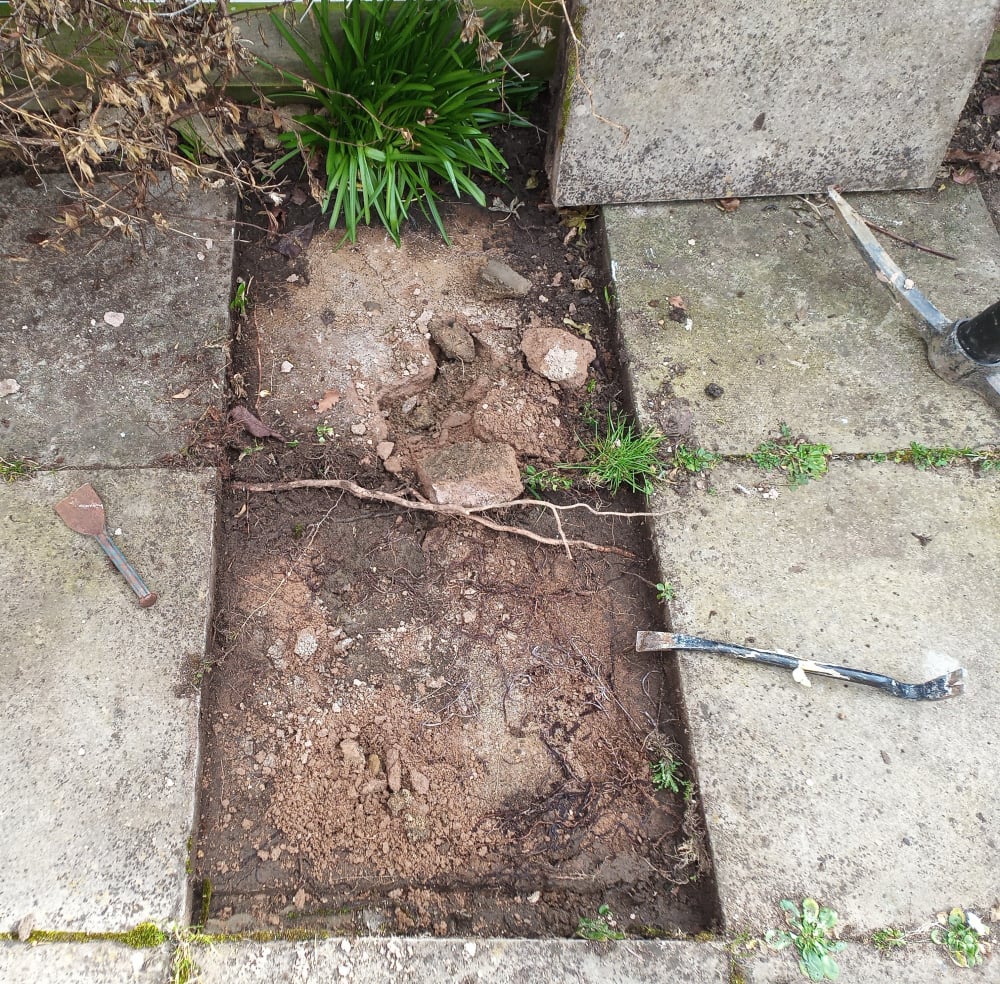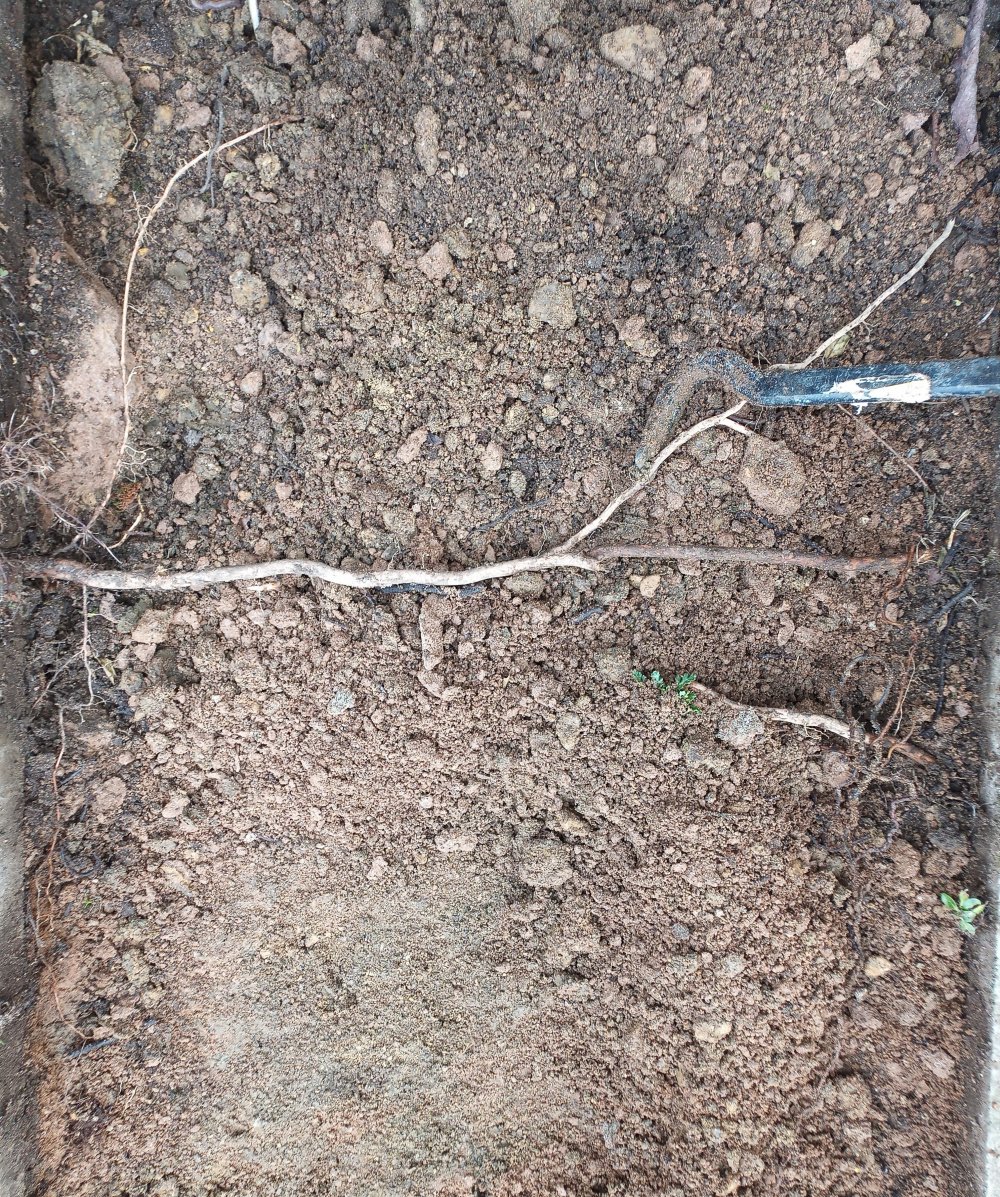This Forum will close on Wednesday 27 March, 2024. Please refer to the announcement on the Discussions page for further detail.
Removing patio slabs for planting
 Randommoose1
Posts: 99
Randommoose1
Posts: 99
Hello,
We are removing some of our patio slabs to make a planting bed. The slabs are 60*60 council slabs and have been laid on a bed of mainly sand, some cement. We are lifting the slabs, then breaking up the cement layer into rocks and removing them. Below that is a sandy layer, then the clay subsoil (which surprisingly isn't compacted so we will be very careful not to walk on this!). However a lot of the sand has mixed with the clay to produce a mix almost like gritty loam. This isn't top soil but has quite a few worms in it. The roots in the picture are a large passionflower and a fuchsia. The bed will have top soil and compost put on top before planting and I imagine will need plenty of organic matter in the next few years.
My question is - can I leave this sand and mix it in with the soil I add? The loose sand doesn't seem to have cement mixed with it (the cement bits are like rocks, I still have small bits to remove) and it has worms in it where it is mixed with soil.
Slabs up, starting to break up the cement (looks like rocks where it is broken up):

After cement removal. Scraped down to bare clay bottom left. Sand middle and right. Mixed with soil top (this is where the worms are):

We are removing some of our patio slabs to make a planting bed. The slabs are 60*60 council slabs and have been laid on a bed of mainly sand, some cement. We are lifting the slabs, then breaking up the cement layer into rocks and removing them. Below that is a sandy layer, then the clay subsoil (which surprisingly isn't compacted so we will be very careful not to walk on this!). However a lot of the sand has mixed with the clay to produce a mix almost like gritty loam. This isn't top soil but has quite a few worms in it. The roots in the picture are a large passionflower and a fuchsia. The bed will have top soil and compost put on top before planting and I imagine will need plenty of organic matter in the next few years.
My question is - can I leave this sand and mix it in with the soil I add? The loose sand doesn't seem to have cement mixed with it (the cement bits are like rocks, I still have small bits to remove) and it has worms in it where it is mixed with soil.
Slabs up, starting to break up the cement (looks like rocks where it is broken up):

After cement removal. Scraped down to bare clay bottom left. Sand middle and right. Mixed with soil top (this is where the worms are):

0
Posts
If you add some rotted manure - you can buy it bagged, that will be even better.
It's not a bad idea to leave it for a while to settle before you plant anything. You'll find it might settle a bit further, and you can then top up the compost etc.
I've done that here, as the 'garden' was mainly slabs and gravel. The slabs were laid direct onto sand which resembled what we call red blaes [ over compacted hardcore ] and is just a red, very gritty, sandy mix. I lifted those, and initially had a raised lawn, but I took that away almost 2 years ago, made a new pond, and I plant direct.
My ground didn't look anything like as good as yours does, but with plenty of additional organic matter added as I plant, it's been fine. I left as much of the soil from the grass as possible, but there's an underlying bed of compacted clay which I've had to improve as much as possible. I grow quite a wide variety of plants in it.
I live in west central Scotland - not where that photo is...
I have some rotted down grass turves I removed a year ago I might mix in, plus will be digging out a pond soon so there will be top soil from that. Then I will get a bulk delivery of some form of organic matter.
When I said to leave it for a little while, I was meaning once you'd added the organic matter, as it will all work it's way into the ground.
I also added plenty of compost when planting anything, and that always pays dividends. Most of the plants I have are fairly moisture loving/tolerant, because of the conditions here, and that's quite important for planting directly into the ground. The plants in the raised beds are the ones which need much better drainage.
You'll be able to tailor the plants to your climate too
I live in west central Scotland - not where that photo is...
Some green-manure planting whilst you are waiting to finish might be a good idea. THis would add plant material deeper down. I am not an expert on this , but it would be easy to research.
I wish more posts would give such good explanations. IF they did they would get better answers.
"Have nothing in your garden that you don't know to be useful, or believe to be beautiful."
I haven't planned what plants yet! I wasn't planning to start this bed yet but I went out earlier and when I came back my husband had started it as he is keen to reduce the paving before summer so there isn't so much retained heat. We are in Gloucestershire though so there are lots of options for planting.
Green manures are a good idea. I used Phacelia as the green manure when I had an allotment and that is so easy to use, lovely flowers and the bees love it. I was already planning to use it for other beds in the garden to test the shape with something that is easy to remove so I could do that here as well. The soil needs to stay mostly covered through summer or it will crack so a phacelia or another green manure will cover it nicely as I plant up over time.
Thank you
I noticed the passionflower stems were looking very dead so scrape checked and they were almost all dead. Normally about 1/3 die over winter but this time all the thin stems except a few near the house had died and some of the thick branches. The sustained -6 degrees must have been a bit much for the thin stems. I expect the plant is still fine, it seems pretty tough and it has twice previously regrown very enthusiastically from being cut down to about 2 foot high. It can easily cover the fence again by summer. So I pruned all that off and cut the fuchsia back a bit as well.
It looks very bare now, though it looks very messy through winters anyway. I am tempted long term to put an (mostly) evergreen climber there instead as our living room patio doors are right there on the left and we see this fence up close all year round. I want the bed to look ok through all the seasons as well as it is our closest view in the garden.
We are going to have to do a lot of trips to the tip with the cement removal! There are already enough buckets to fill the boot of the car and that is just 4 slabs worth. Hopefully someone on freecycle or similar will want the slabs, carrying up the stairs to the rubble container at the tip would be too difficult.
Some people try to do that because, for example- they want acid loving plants and have alkaline soil, maybe want hydrangeas in blue rather than pink [or the opposite way round for acid with hydrangeas] but the effect is short lived in the ground. It would need to be in a contained area, large pot or similar, to be effective.
However, as your soil is already alkaline, you would have to use suitable plants anyway so it won't matter. Pink hydrangeas for you - or white, as they don't change anyway
I live in west central Scotland - not where that photo is...
I have three white Hydrangea macrophyllas, Libelle, Mme Emile Moulière and Lanarth White. The little fertile flowers do change colour with pH. The white of the bracts looks more white with the blue than the pink.
"Have nothing in your garden that you don't know to be useful, or believe to be beautiful."
The oak leaf ones are great though - they retain their white colour well, starting off slightly green before getting white, although it's the foliage colour which is the real attraction of those. They would be perfect for you regardless of your soil as they don't mind, and can be happy with a bit of alkalinity. They'll also take a bit more sun without being adversely affected
I live in west central Scotland - not where that photo is...